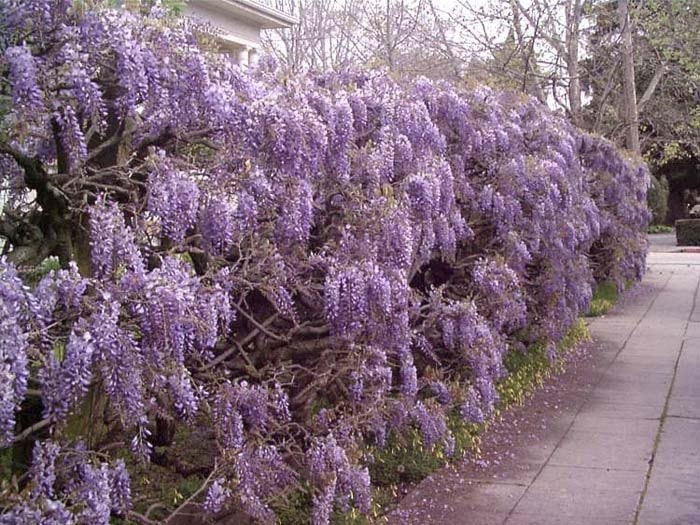Looking for a simple but fast cover-up to screen an old fence or wall, an unsightly building or a nosy neighbour? Why not make good use of some interesting and attractive vines.
Most folks plant vines, like clematis and honeysuckle, for their lovely flowers, but attractive, carefree foliage is also something to be considered. One of the most unusual and attractive is a delightful kiwi vine that has dappled pink edges on its leaves all summer long. The leaves come out green in the early spring, then turn white and, eventually, pink. It has small white flowers that can be pollinated by planting both male and female vines. Its fruit, which is simply delicious, is very similar to the small grape-like kiwi. Its proper name is Actinidia kolomikta.
For fast growing vines that are great cover-ups on chain fences or unattractive cement walls, try one of the many forms of Virginia Creeper. Parthenocissus quinquefolia is the traditional large-leafed variety that turns brilliant red in fall. The so-called 'Boston Ivy', P. tricuspidata ‘Veitchii, has smaller and more elegant foliage with all the same characteristics. Its new growth is a purple red all summer long, and this plant is quite pollution resistant. There are a few new varieties now available, like P. henryana, that have attractive variegated foliage. Even in winter, the massive network of vines makes them effective.
A very classy and elegant vine that is seldom used is a dainty small-leafed akebia. It is a semi-evergreen vine that produces fragrant small purple flowers that are in bloom right now. This Japanese native also produces small, sausage-shaped fruit. It is an effective, fast growing vine that would be useful almost anywhere.
The vine being promoted in many magazines today is the 'Hummingbird Vine'. In our region it does not bloom until mid-summer, but when it does, its huge orange to scarlet blossoms are really quite something. Its leaves are very lush and fast growing, making it an ideal cover for old stumps, walls or trellises. There are many varieties available today, but ask for Campsis radicans or C. tagliabuana 'Madame Galen' for the bright orange flowers that appeal to hummingbirds. The newest variety, ‘Indian Summer’, has a slightly lighter orange colour but blooms earlier and longer. It’s quite amazing. All campsis need little care but must have a hot, sunny area for the best performance. They can be invasive, so root pruning is recommended to keep them well behaved.
If you want ‘fast’, then one vine I really should mention is the 'Silver Lace Vine', Polygonum aubertii. Often called the Mile-a- Minute Vine, it is among the fastest growing, stretching up to twelve feet per season. To cover a patio, pole, old fence or anything unsightly for that matter, it is the best. I have run these vines up evergreen trees for a striking effect each summer as the lacy white blossoms provide a nice contrast. It is the vine which seems to grow anywhere, with little care.
I once visited a gardener who smothered a rather unattractive old shed wall with several varieties of honeysuckle. Not only did they look great, but their fragrance also filled his entire garden. I was not the only admirer either, as several hummingbirds were sipping nectar from the long slender florets of a variety called 'Dropmore Scarlet'. My favourite variety is the soft yellow, very perfumed ‘Halliana’. There is a new variety, called ‘Honey Baby’, that grows only to six feet and has yellow perfumed flowers all summer long. All varieties can suffer from mildew and aphids.
Wisteria also grows quickly, and whether it be the white, pink or blue variety, is noted for its rapid growth and clean appearance. By the way, the Chinese varieties grow anti-clockwise, while the Japanese varieties grow clockwise! The Japanese (floribunda) types tend to bloom far earlier than the Chinese (sinensis) varieties, which often take up to seven years for the first blooms to appear. My advice: purchase larger grafted varieties for earlier blooming.
If you have a really shady spot, then the climbing hydrangea is absolutely the best. 'Hydrangea petiolaris' is an excellent, lush green climber with rounded, heart-shaped leaves. Its large, flat white flower clusters look absolutely smashing in June. Its newer, more dainty cousin, ‘schizophragma’ comes in both pink and white.
Another somewhat forgotten vine is the Porcelain Vine (Ampelopsis elegans) which has dainty white and green foliage that is a true class act in full sun or partial shade.
Vines are great, easy to grow, colourful and effective in solving so many landscape problems! Take a good look around your garden and see if a few vines here and there wouldn't improve the overall appearance, or at least cover up a few of those trouble spots.
